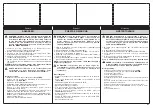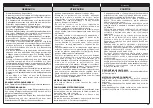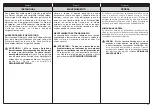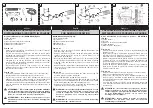
28
Italiano
English
Français
UTILIZZO
USE
UTILISATION
TIVEK, stivali di gomma e simili.
- In caso di contatto con occhi o ingestione di prodotti
chimici o miscela di prodotto consultare un medico
portando con se la targhetta del prodotto ingerito.
- Lavare con cura, prima di riutilizzarli, tutti gli indumenti
che entrino in contatto con la miscela chimica sia essa
pura o diluita.
- Non fumare, bere e mangiare durante la preparazione
o la distribuzione della miscela e nei pressi o all'interno
di appezzamenti trattati.
- Trattare rispettando le distanze di sicurezza da centri
abitati, corsi d'acqua, strade, centri sportivi, verde
pubblico o sentieri di uso pubblico.
- Lavare con cura i contenitori dei fitofarmaci
sciaquandoli più volte con acqua pulita, quindi riporli
asciutti in appositi sacchi di plastica. I liquidi di
lavaggio possono essere utilizzati per il trattamento.
- I contenitori vuoti devono essere consegnati agli
appositi centri di raccolta nel rispetto della legislazione
nazionale e delle direttive impartite a livello territoriale.
I contenitori non devono essere mai abbandonati
nell’ambiente e non devono essere riutilizzati per
nessun altro scopo.
- Terminata l'irrorazione lavare con cura l'atomizzatore
diluendo i residui con una quantità di acqua almeno 10
volte superiore allo stesso residuo ridistribuendo la
miscela ottenuta sul campo trattato.
- Con l’utilizzo di prodotti chimici aggressivi intensificare
i controlli delle membrane; dopo ogni utilizzo
dell’idrossido di rame occorre lavare l’impianto.
- E’ necessario disporre di acqua pulita nelle vicinanze
del luogo dove viene effettuato il trattamento.
PRECAUZIONI CONTRO GLI INCENDI
Non avvicinare fiamme o fonti di calore all’atomizzatore.
CONDIZIONI METEREOLOGICHE
Si consiglia di trattare nelle prime ore del mattino o nelle
ultime ore del pomeriggio evitando le ore più calde del
giorno.
Non trattare mai se il tempo minaccia pioggia o se
piove.
Non trattare in presenza di vento forte o comunque
superiore a 3/5 metri al secondo.
- In case of eye contact or ingestion of chemical
products or mixture consult a doctor, and take the
nameplate of the product ingested with you.
- Garments that come in contact with chemical mixture
being pure or diluted, must be carefully washed before
being re-used.
- Do not smoke, drink and eat during the preparation or
distribution of the mixture, and also near to or inside
plots of ground already treated.
- Treat plots of ground respecting safety distances from
neighborhoods, watercourses, roads, sports centers,
public greens or paths of public use.
- Empty chemicals containers should be rinsed out
repeatedly with clean water, dried, and put into special
plastic disposal bags. The rinse liquids can be used
subsequently for the crop treatment.
- Empty containers must be taken to designated
collection centres, in accordance with national
statutory regulations and local bylaws. Containers
must never be dumped or disposed of as normal
refuse, and must not be reused for any other purpose.
- After spraying, carefully wash the mistblower diluting
residual with a quantity of water at least 10 times
higher than residual, and redistributing the obtained
mixture on the treated field.
- Intensify control of the state of the membrane after
using aggressive chemical products; accurately wash
the complete system after using copper hydroxide.
- There must be a supply of clean water on hand near
the site where the treatment is being carried out.
PRECAUTIONS AGAINST FIRE
Do not approach the mistblower with fire or heat
sources.
METEROLOGICAL CONDITIONS
It is advised to treat early in the morning or in the latter
part of the afternoon avoiding the warmer hours of the
day.
Never treat before or while raining.
Never treat with strong wind or with winds higher than
3/5 meters per second.
- Les lieux de stockage doivent être protégés et leur accès
doit être interdit aux personnes étrangères et aux enfants.
- Manipulez les produits avec précaution. Portez des gants
en caoutchouc résistants aux acides, des lunettes -
masques ou casques d'épuration, des vêtements
hydrofuges ou en TIVEK, des bottes en caoutchoucs et
autres EPI similaires.
- En cas de contact avec les yeux ou d'ingestion de produits
chimiques ou de mélange de produit, consultez un
médecin en lui faisant voir la fiche du produit avalé.
- Avant de les réutiliser, lavez soigneusement tous les
vêtements qui sont entrés en contact avec le mélange
chimique, qu'il soit pur ou dilué.
- Il est interdit de fumer, boire ou manger pendant la
préparation ou la vaporisation du mélange et à proximité
ou sur des terrains traités.
- Traitez en respectant les distances de sécurité de centres
habités, cours d'eau, routes, centres de sport, parcs
publics ou sentiers publics.
- Laver les récipients contenant les antiparasitaires avec
précaution; les rincer plusieurs fois à l'eau propre puis les
ranger, secs, dans des sachets en plastique. Les liquides
de lavage peuvent être utilisés pour le traitement.
- Les récipients vides doivent être confiés à des centres de
collecte appropriés, conformément à la loi nationale et aux
directives adoptées au niveau territorial. Ne jamais jeter les
récipients dans la nature et ne les réutiliser sous aucun
prétexte.
- Une fois la vaporisation terminée, lavez soigneusement
l'atomiseur en diluant les résidus dans au moins 10 fois
leur volume d'eau et en revaporisant le mélange ainsi
obtenu sur le champ traité.
- Pour l'utilisation de produits chimiques agressifs, intensifier
les contrôles des membranes; laver le circuit après chaque
utilisation d'hydroxyde de cuivre.
- Prévoir de l'eau propre à proximité de l'endroit où le
traitement est effectué.
PRÉCAUTIONS CONTRE LES INCENDIES
Veillez à ne jamais avoir de flammes ou de sources de
chaleur à proximité de l'atomiseur.
CONDITIONS MÉTÉOROLOGIQUES
Lorsque la température extérieure est élevée, effectuer le
traitement tôt le matin ou en fin d'après-midi en évitant les
heures de grosses chaleurs.
Ne traitez jamais sous la pluie ou s'il risque de pleuvoir.
Ne traitez pas en présence d'un vent fort ou, de toute façon,
de force supérieure à 3/5 mètres/seconde.
















































